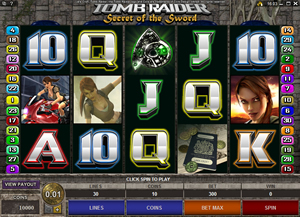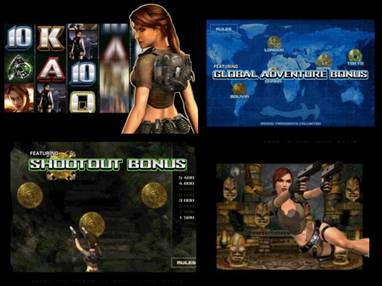|
Tomb
Raider
Captain
Cooks Casino website Captain
Cooks Casino profile Microgaming

TOMB
RAIDER: Secret Of The Sword profile Lara
Croft profile


Website
Captain
Cooks Casino
Tomb
Raider - Secret Of The Sword video slot game


Tomb
Raider Movie Angelina
Jolie profile
Tomb
Raider - Secret Of The Sword video slot game



Game
review
Tomb
Raider: Secret of the Sword
Tomb
Raider™, Secret of the Sword is the worthy
successor of the original Tomb Raider™ video
slot released by Microgaming back in 2004 and
further continues the adventures of Lara Croft™,
the world’s most famous archaeologist. Put
all of Lara’s skills to the test and guide
her as she discovers the true winning power of
Tomb Raider™, the Secret of the Sword.
*
5 Reels
* 30 Paylines
* Scatters feature
* Free Spins
* Unique Global Adventure Bonus
* AND an extreme 135,000 coin Jackpot!
Profile
Tomb
Raider is a series of action-adventure games,
comic books, novels, theme park rides, and movies,
centring around the adventures of the female fictional
British archaeologist Lara Croft. Since the release
of the original Tomb Raider in 1996, the series
developed into a lucrative franchise of related
media, and Lara went on to become a major icon
of the video game industry. The Guinness Book
of World Records has recognised Lara Croft as
the "Most Successful Human Videogame Heroine"
in 2006. Six games in the series were developed
by Core Design, and the latest two by Crystal
Dynamics. All the games were published by Eidos
Interactive, which holds the rights to the Tomb
Raider trademark and characters of the franchise.
To date two movies, Lara Croft: Tomb Raider and
Lara Croft Tomb Raider: The Cradle of Life, have
been produced starring American actress Angelina
Jolie as Lara Croft.
Lara
Croft
The
central character in Tomb Raider is the sexy,
no-nonsense, British archaeologist Lara Croft,
a female character similar to Indiana Jones in
search of ancient treasures.
Lara
was created by one-time Core designer Toby Gard,
and grew out of a number of ideas discarded in
early concepts. She appears almost invariably
with brown shorts, a blue top, holsters on both
sides of her hip for dual wielded pistols and
a small brown backpack. Over the course of the
series, she has undergone minor adjustments, such
as smoother facial features, enlarged (and later
reduced) breast size and free moving hair.
Several
real-life persons have taken on the role of portraying
Lara Croft in flesh, most notably British actresses
Nell McAndrew (who was an official model) and
Rhona Mitra (in the early days of the games' success),
and American actress Angelina Jolie in the Tomb
Raider movies. In addition, playing Lara at game
conventions is a popular type of modelling work.
Alison Carroll is the current official portrayer
of Lara.
Ten
years after the release of the original game,
Lara is still one of the most durable and recognisable
video game characters. Alternatively viewed as
a feminist icon or a sexist stereotype, the impact
of her character on popular culture is undeniable.
Continuities
There
are two different continuities to the game series.
The first encompassing the first six games, and
the second starting with Legend and including
Anniversary. Although Anniversary is a remake
of the original Tomb Raider, the story has been
revised to fit into the second continuity, although
plot elements present in Tomb Raider Legend are
not explicitly referenced.
The
first continuity is often referred to as the Core
Design continuity and the second is usually referred
to as the Crystal Dynamics continuity, based on
the company that developed each game. Differences
between the continuities are particularly apparent
in Lara Croft’s backstory, as well as her
personality. Croft Manor also looks extremely
different between the continuities. It could also
be stated that there are additional continuities
in the Tomb Raider series as the movies and comic
books have significant differences from the games.
For example, in the first continuity and in the
comics, Lara lost both her parents and her fiancée
in a plane crash that occurred during her early-twenties.
However, in the second continuity, it is noted
that this crash happened when she was nine, and
she lost her mother as an indirect result of the
crash. Both the second continuity and the film
continuity mention the loss of her father in Cambodia.
The
second continuity borrows some elements from the
films. For example, the layout of Croft Manor
in both Legend and Anniversary is extremely similar
to that featured in the films.
Game
features
The
original game, titled Tomb Raider, made its début
on the Sega Saturn, PlayStation and PC. Despite
being released on the Saturn first, it was one
of the titles responsible for the PlayStation's
success in the mid 90s. The games present a world
in 3D: a series of tombs, and other locations,
through which the player must guide Lara. On the
way, she must kill dangerous animals and other
creatures, while collecting objects and solving
puzzles to gain access to an ultimate prize, usually
a powerful artefact. In later games, Lara's targets
become predominantly human, which has sparked
some criticism from gamers who feel the games
became too violent.
Tomb
Raider is an earlier example of the 3D genre.
The game is a third-person shooter since Lara
is always visible. The player's camera follows
her, usually over her shoulder or from behind.
Up until Tomb Raider: The Angel of Darkness, the
game was characterised by the cubic nature of
the world in which Lara inhabits. Ledges, walls
and ceilings sit at 90 degrees to each other,
although the game designers use some clever tricks
to make this less obvious.
A
reason for this orthogonality can be explained
by the fact the creators took the 2D platform
game genre and extended it to a 3D world. This
is shown through Tomb Raider's gameplay, which
is very reminiscent of older platform games like
Prince of Persia and Flashback that had a heavy
focus on timed jumping interspersed with combat.
Each game has introduced new weapons and moves;
by the fourth game, Lara could backflip off ropes
and turn around in mid-air to grab a ledge behind
her. Tomb Raider: Legend introduced an electromagnetic
grapple that Lara can attach to metal objects
and can, amongst other things, be used to make
rope swings and pull metal objects (and enemies)
toward her.
Standard
moves in Lara's range of abilities include the
somersault, a roll, climbing techniques, the ability
to swim, a swan dive manoeuvre, and a handstand.
The last two abilities are purely aesthetic and
serve no other function in the game. In Tomb Raider
III, a sprinting move was introduced that allowed
Lara to quickly speed up
while
a bar in the lower corner of the screen drained
her stamina. In Tomb Raider: Chronicles, Lara
was able to somersault/roll out of crawl spaces
higher than ground level.
The
storyline is usually driven by the quest for a
powerful artefact, with Lara in a race against
a sinister shadow league who want to obtain the
relic for their own purposes. These artefacts
usually possess mystical powers and may be of
supernatural, or even alien, origin. Often in
the series, the antagonist uses the artefact or
bits of it to create terrifying mystical monsters,
creatures, and mutants in which Lara must defeat
throughout the journey.
Future
instalments
After
the success of Legend (more than 2.6 million units
sold worldwide in five weeks), Crystal Dynamics
is planning an eighth instalment in the Tomb Raider
series.
Music
The
basic instrumentation for the Tomb Raider scores
is orchestral, though the games adopt different
instrumentation and tone with each instalment
in the series. The majority of Tomb Raider music
has been created using electronic technology,
such as samples and synthesizers (though the Tomb
Raider: Angel of Darkness soundtrack was performed
by the London Symphony Orchestra). The symphonic
sounds of the earlier games were created using
Roland Corporation's Orchestral Expansion board
for their JV series keyboards. Tomb Raider: Angel
of Darkness brings the "next generations
Lara" and also a new perspective (constant
music) on the Tomb Raider music, because the first
5 games of the series, not only that uses the
same engine but the music remains unchanged, the
instrumentation is the only aspect that suffers
variations.
Some
short in-game tunes of the first 5 games of the
series were used to prevent the player about the
danger will come. The "danger tunes"
are loud and scary. Other short tracks were used
after the player discovers a new chamber or reveals
new places. On the moment you enter and discover
a new chamber, while the player is supposed to
be gazing at the place and thinking about solving
the new puzzle of this chamber, a short track
starts playing. The aftermath of the "reveal
tunes" is that on the moment they start they
trigger the feeling of mystery of the place where
and the need to unlock its puzzle.
The
sound effects of the games are also edited by
the main composers of each game.
The
most recognizable sound of the game is a short
vibraphone sound which is played Lara finds a
secret element of the game. The sound has been
used in the first five Tomb Raider video games,
including Lara Croft Tomb Raider: Anniversary
though it has some insignificant sound variations.
Movies
The
idea of Tomb Raider was extended beyond being
just a video game, including the 2001 movie Lara
Croft: Tomb Raider and the 2003 sequel Tomb Raider:
The Cradle of Life, both starring Angelina Jolie.
A
fair percentage of fans of the game argue that
the movie adaptations are a poor tribute to their
video game heritage, though Jolie, after some
initial published criticism mostly centred around
her being an American playing a British character,
was considered an ideal choice for the role of
Lara Croft.
Lara
Croft: Tomb Raider (2001)
Tomb Raider
A
member of a rich British aristocratic family,
Lara Croft is a "tomb raider" who enjoys
collecting ancient artefacts from ruins of temples,
cities, etc. worldwide, and doesn't mind going
through death-defying dangers to get them. She
is skilled in hand-to-hand combat, weapons training,
and foreign languages - and does them all in tight
outfits.
The
planets of the solar system are going into astronomical
conjunction (which occurs every 5,000 years),
and a secret society called the Illuminati is
seeking an ancient talisman called The Triangle
of Light that gives its possessor the ability
to control time. The Illuminati need a certain
clock/key called the All-seeing Eye to help them
in their search, and they have to find it in one
week or wait for the next planetary alignment
to find it again which will be in another 5,000
years. Lara happens to find the All-seeing Eye
hidden in a wall of her mansion. The Illuminati
steal it, and Lara gets an old letter from Lord
Richard Croft, her deceased father, telling her
about the society's agenda (Her father was a defected
member, who hid the key). Now, she must retrieve
the key and find and destroy the talisman before
the Illuminati can get their hands on it.
Tomb Raider: The Cradle of Life (2003)
Lara
Croft returns in the sequel to the original video
game based film. This time, she is trying to find
Pandora's Box which supposedly contains one of
the deadliest plagues on Earth, before evil scientist
Jonathan Reiss can get his hands on it. The key
to finding the Box, which is hidden in the mysterious
Cradle of Life, is an orb that is supposed to
be some type of a map. When Croft goes to get
the orb, it is stolen by Reiss's henchman and
so she recruits an old friend, Terry Sheridan,
a former mercenary who spent his last couple of
years in prison in Siberia, to come to help. Lara
and Terry embark together on an adventure that
spans continents in an attempt to regain the orb.
Comic books
Tomb Raider (comics)
Tomb
Raider has been licensed to Top Cow Productions,
which has published a large number of Tomb Raider
stories in comic book form since 1999. The series
ended in 2004 with the release of its final and
fiftieth comic book.
Original
novels
Ballantine
Books, in conjunction with Eidos, began publishing
a series of original novels in the spring of 2004,
beginning with The Amulet of Power by Mike Resnick,
which was followed by The Lost Cult by E. E. Knight
in August 2004 and then The Man of Bronze by James
Alan Gardner in January 2005. They generally followed
the continuity of the video games (particularly
Angel of Darkness) rather than the movies, although
Lost Cult contained references to Cradle of Life.
Man of Bronze differs from the first two books
in that it is told in first-person narrative from
Lara Croft's point of view.
Ballantine's
contract only called for three novels, and it
is not yet known if the book series will continue.
Theme Park Rides
Tomb Raider (comics)
The
film Lara Croft: Tomb Raider and subsequent sequel,
having been distributed & licensed by Paramount
Pictures were fair game for inclusion in the six
Paramount Parks, theme parks owned and operated
by Paramount (and later, CBS Corporation. As such,
three "Tomb Raider" rides were opened
at various Paramount Parks: Tomb Raider: The Ride
(both a HUSS Giant Top Spin at King's Island and
a flying roller coaster at Canada's Wonderland)
and Tomb Raider: FireFall (a suspended HUSS Top
Spin at King's Dominion). The Paramount Park's
sale to Cedar Fair, L.P. was accompanied by a
loss of rights to the Tomb Raider name, and subsequently,
King's Island's "Tomb Raider: The Ride"
and King's Dominion's "Tomb Raider: FireFall"
were renamed "The Crypt" (to which there
is much controversy) while Canada's Wonderland's
"Tomb Raider: The Ride" was renamed
"Time Warp."
With
it's investments & licensing pulled from the
former Paramount Parks, the Tomb Raider ride franchise
was started anew with Tomb Raider: The Machine
at Movieland Studios, Italy. The ride, manufactured
by Zamperla, looks very much like the HUSS Top
Spin ride, but is actually a new ride called a
Windshear].
The
original (and only indoor, themed) Tomb Raider:
The Ride at King's Island was
celebrated
for the way it turned what is generally a typical
"boring" thrill ride like a Top Spin
(something found at most carnivals) into a highly
interactive, themed dark ride complete with lava
pits, volcanoes, icicles, and a giant goddess
carving on the wall with laser eyes. The ride
was synchronized to a specially-made Tomb Raider
soundtrack and featured the real, six armed "Durga"
goddess and water vase from the first movie, as
well as the monkey warrior statues that come to
life in the film.
Animation
Re\Visioned: Tomb Raider Animated Series
GameTap
aired a ten part animated short series called
"Re\Visioned: Tomb Raider Animated Series"
from July 10th, 2007 to November 13th, 2007. The
series is comprised of various artistic talent's
renditions of Lara Croft. Minnie Driver provides
the voice for Lara Croft. (Credit:
Wikipedia).
Profiles
Lara
Croft
Games
Gaming
Animation
Virtual
Worlds
Casino
News
Casino
News
|



